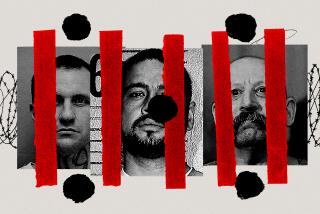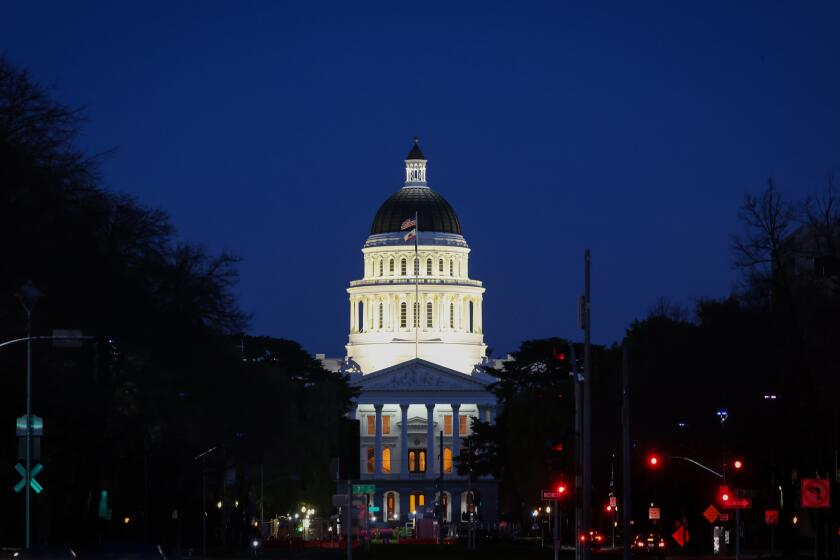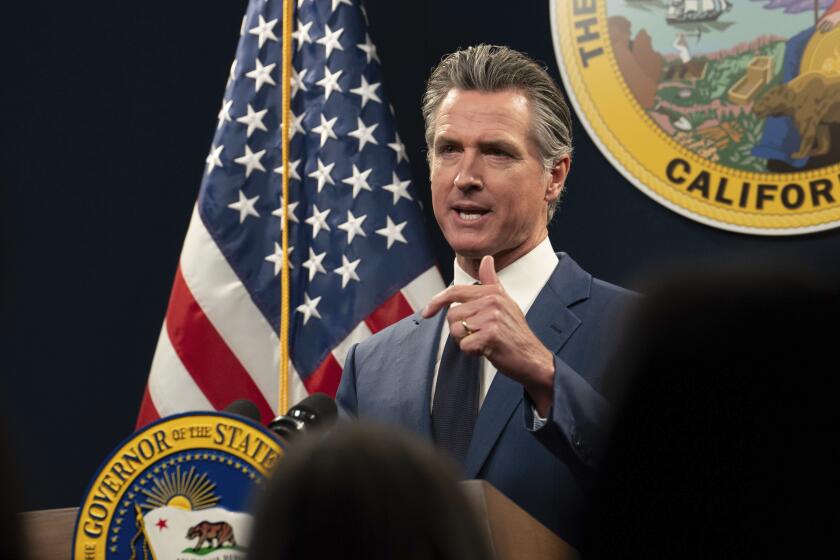COLUMN ONE : Hospitality Turns Into Hostility : California has a long history of welcoming newcomers for their cheap labor--until times turn rough. The current backlash is also fueled by the scope and nature of the immigration.
Like tectonic plates, two relentless forces are colliding to produce the political earthquake over immigration that is shaking California.
On one side is a demographic remaking of the state: a dramatic rise in immigration--legal and illegal--that has swelled the foreign-born share of the state population to the highest level since 1920.
On the other is the economic unmaking of the state: a sustained economic slump that has swelled unemployment, strained finances and eroded the optimism about the future that Californians for generations have assumed as a birthright.
Throughout the state’s history, the combination of rising immigration, economic contraction and anxiety about the future has been explosive. From its founding, California has followed a schizophrenic pattern of welcoming immigrants at times of economic need, then turning against them, either when the economy soured or the ranks of newcomers reached critical mass.
“California has a long and unfortunate history of treading on immigrants after they have been welcomed,” said Wayne Cornelius, an immigration expert at the UC San Diego Center for U.S.-Mexican Studies.
Now, in the crucible of the state’s worst economic downturn since the Depression, the historic pattern is reasserting itself.
In the last three decades, with only intermittent murmurs of concern, California has integrated into its economy millions of legal and illegal immigrants as workers in factories, restaurant kitchens, farm fields and construction sites, as nannies in middle-class homes and gardeners of lavish estates.
“When things are going well and there’s a shortage of labor, people either look the other way or are actively supportive of bringing cheaper labor into the United States,” said Bruce Cain, associate director of the Institute of Governmental Studies at UC Berkeley. “There probably are a very high fraction of middle-class homeowners in this state that have used immigrant labor in one form or another to do something and have reaped the economic benefits of having a cheaper labor supply.”
But that equilibrium has been torn apart by the force of economic trends and the flow of immigration. Among the key factors:
* The explosive rise in the level of immigration in which more arrivals entered California in the 1980s than in the previous three decades combined.
* A slowdown in the state economy that has cost California more than 830,000 jobs in the last three years and raised anxieties about competition for work posed by the arrivals, both legal and illegal.
* The recession-induced strains on state and local budgets that have made the public more receptive to California Gov. Pete Wilson’s arguments that the state can no longer afford to provide as many public services to illegal immigrants.
* The preponderance of newcomers from a single source--Mexico--that appears to be sharpening fears among many U.S.-born residents about the Balkanization of American culture.
Together, these powerful forces are sharpening the lines for a debate over immigration that is likely to divide the state more than any other issue through the 1990s. Wilson, facing a battle for reelection next November, galvanized the issue earlier this year with his polarizing proposals to deny benefits to illegal immigrants--including the automatic right of citizenship to the U.S.-born children of illegal migrants.
Now virtually every officeholder in the state is rushing forward with proposals to combat the flow of illegal immigrants--from deploying the National Guard along the border to deporting illegal immigrants held in California jails.
“There’s suddenly a sense that we can’t afford this,” Cain said. “We tolerate it only insofar as the net benefit is good. But when jobs are tight, and the cost of supporting people goes up, then we suddenly redo the calculus.”
Advocates for immigrants are firing back with charges of nativism, racism and scapegoating. But they are bracing for difficult months and years ahead. “Part of the dilemma for those of us in immigrant rights is who (among public officials) are our friends anymore?” said Angelo Ancheta, head of the Coalition for Humane Immigrant Rights of Los Angeles and the son of Filipino immigrants. “Are there any friends left?”
In no other state have concerns about immigration reached the intensity they have here. But in less concentrated form, the key factors driving the debate over immigration in California are present at the national level too.
“There is a notion that we are ‘full’--that there are not enough opportunities to go around,” Democratic pollster Mark Mellman said. “Today the notion is (that) the pie is shrinking and that each new person who arrives not only takes a piece of the pie, but takes it from me.”
On these waves of anxiety, the issue is relentlessly rolling east. In 1986, Congress passed sweeping legislation to choke off the flow of illegal immigrants by punishing employers who hire them. Now there is widespread agreement that employer sanctions have failed, and proposals are proliferating in Washington for measures to stem the flow--from beefing up the Border Patrol to creating a tamper-proof national ID card to discourage illegal immigrants from seeking jobs or government benefits.
The Clinton Administration has proposed to stiffen procedures for reviewing refugee and asylum claims--and others in Washington are discussing a rollback of the 40% increase in legal immigration that Congress approved with relatively little rancor three years ago.
“It used to be a political risk to deal with immigration, whether legal or illegal,” said Alan Nelson, former Immigration and Naturalization Service commissioner and a lobbyist for FAIR--Federation for American Immigration Reform, a leading anti-immigration group. “And the politicians tended to run from it. Now it’s almost a 180-degree shift. It’s sort of a political necessity that you’ve got to deal with the issue.”
Politicians may be focusing attention on immigration for their own reasons, but the issue’s political life begins with a basic reality: The United States, and particularly California, is being transformed by a wave of immigration as powerful as any in its history.
From 1880 to 1920, in a country with far less than half of today’s population, the United States absorbed 23.5 million immigrants, the vast majority of them from Europe. Then an economic and cultural backlash led Congress to restrict immigration in 1921 and 1924. It established a national origins quota system for admissions that reduced immigration levels and favored groups already well represented in the country by 1890--essentially migrants from Northern and Western Europe.
For the next 40 years, Congress did little more than tinker. But in 1965 it substantially liberalized immigration by junking the quota rules and replacing them with a system that gave highest preference to close relatives of U.S. citizens and those with skills that were said to be needed by U.S. employers.
Three times since 1980, Congress has returned to the immigration issue: In 1980, it passed legislation easing the admission of refugees; in 1986, it approved the landmark legislation that coupled amnesty for millions of illegal immigrants with efforts to restrict future entry, and in 1990, another sweeping revision increased the overall level of legal immigration.
Taken together, these laws have recast U.S. immigration policy in two elemental respects. One has been to shift the flow of immigration away from Europe and Canada--which together provided three-fourths of the immigrants during the 1950s--to Asia and Latin America, which accounted for 85% of legal immigrants during the 1980s.
The other has been to enable the century’s second great wave of immigration. No one knows exactly how many people enter the United States every year. But a consensus estimate is that the nation takes in more than 1 million immigrants annually. The INS says about 693,000 immigrants entered the country legally in 1992, along with 120,000 refugees and asylum-seekers. In addition, groups on both sides of the immigration debate estimate that despite the 1986 reform law, about 300,000 illegal immigrants enter the country every year. Only around the turn of the 20th Century has the country absorbed so many people at once.
Like waves on a beach, these human flows are literally remaking the face of America. After declining steadily from 1920 to 1970, the share of the U.S. population that was born abroad increased from about 5% in 1970 to nearly 8% in 1990. Jeffrey S. Passel, director of immigration policy research at the Urban Institute in Washington, D.C., projects that the combination of high immigration levels and low birthrates among natives will push the foreign-born share above 10% by the end of this decade, a level not seen since 1930.
Once established, immigrant communities tend to attract other immigrants. Although the current wave of immigration is being felt everywhere, the most dramatic impacts are in a handful of states. In 1960, 62% of all foreign-born Americans lived in seven states; by 1990, three-fourths of the new arrivals flowed to those same states.
At the top of that list is California. During the 1980s, nearly one-quarter of all legal immigrants to the United States settled in California, and more than half of the 3 million illegal immigrants granted amnesty under the 1986 immigration reform law settled in California. Moreover, the INS estimates that nearly 1.3 million illegal immigrants live in the state, about 40% of the nation’s 3.2-million total.
Overall, California’s foreign-born population has increased from 1.3 million in 1960 to 6.45 million in 1990--from about 9% to 22% of the population, the largest share since at least 1920. Today in Los Angeles County, nearly 33% of the population is foreign-born--up from 11% in 1970--and it is not unusual to find a mosque or Sikh temple down the block from McDonald’s golden arches. Although the largest number of immigrants are Latinos or Asians, the foreign-born include Russians and Iranians, Armenians and Lebanese and people from around the globe.
At county-run Martin Luther King Jr./Drew Medical Center hospital in South-Central Los Angeles, 85% of the births are Latino. In parts of the San Fernando Valley, once a national symbol of a white, middle-class suburbia, bakeries are now panaderias and the Church of God is Iglesia de Dios. Latinos, now 28% of the state’s population, are projected to become the majority by 2040. The change is even more dramatic in Los Angeles County as a whole, where Latinos--nearly 40% of the population--are projected to become the majority by 2007.
History of Extremes
At regular intervals, California has recoiled from such powerful demographic change.
If the state has long been a principal port of entry, it also has been a wellspring for nativist and exclusionary movements--from the Workingmen’s Party that organized against Chinese immigrants in San Francisco in the mid-19th Century, to the Asiatic Exclusion League of California that pressed Congress to cut off Japanese immigration in the 1920s. “California was always an extreme,” said Rita J. Simon, a sociologist at American University.
No single factor explains the volatility of California’s reaction to immigrants. One key, though, may be that California throughout its history has faced integrating an immigrant population that is primarily non-white. And those racial differences have intermingled explosively with economic anxieties when boom turned to bust.
Chinese immigrants were the first to come in large numbers--lured by gold and recruited by the railroads in the 1850s. They were welcomed at first as a source of cheap labor--laying railroad tracks across the Sierra in the killing winter without complaint. But soon after, the state imposed its first restrictionist law--a $20 monthly tax on foreign miners. Once the transcontinental railway was completed in 1869, the Chinese migrated into cities and tensions heightened.
In 1882, pressure from California was instrumental in the passage of federal legislation barring foreign-born Chinese from acquiring citizenship and banning the entry of Chinese workers for decades.
Once the nation excluded Chinese immigrants, California agricultural interests began recruiting the Japanese to replace them around the turn of the century. Like the Chinese, Japanese immigrants were at first welcomed. But success brought retribution.
In 1906, the San Francisco school board set off an international incident by segregating Japanese schoolchildren. “The Japanese government was so ticked off that they inquired whether Japan could declare war just on California,” historian Kevin Starr said. It took the federal government to persuade the San Francisco board to rescind its order.
With other groups, the pattern persisted: a welcome that curdled into resentment. By 1929, race riots flared against Filipino laborers. When the Depression hit, Mexican workers--who had been recruited earlier as a source of cheap agricultural labor--were deported by the hundreds of thousands. This exclusionary impulse has been constantly counterbalanced by an insatiable desire for cheap labor to fuel the state’s growth. Not long after the mass deportation of Mexicans during the Depression, California agriculture--then the state’s largest and most powerful industry--persuaded Congress during World War II to establish the bracero guest worker program that brought in hundreds of thousands of Mexican immigrants.
Even after the bracero program was repealed in 1964, much of the state winked as illegal immigrants flowed back into California in ever-larger numbers, finding work not only in farms and factories, but in upper- and even middle-class homes. Shortly after the 1978 passage of the tax-slashing Proposition 13, the cost of providing health care to illegal immigrants emerged as a hot topic of debate at meetings of the Los Angeles County Board of Supervisors.
In 1986, in a surge of national concern over illegal immigrants, Congress passed the landmark Immigration Reform and Control Act. But until recently, few state leaders appeared even mildly annoyed about the law’s palpable failure to stem the flow of illegal immigrants.
To this historic hunger for inexpensive labor, state leaders in the last two decades have articulated a second rationale for welcoming immigration--a vision of California as the multicultural capital of a new Pacific Basin world axis, culturally and economically enriched by its diversity.
Voices committed to that vision still exist, but they are increasingly being overwhelmed by the clamor for measures to stem the flow of arrivals, particularly illegal immigrants.
According to a recent Los Angeles Times Poll, these concerns are strong in white and black communities. But they are present even among Latinos, the state’s largest immigrant group. In the September survey, Latinos were more likely to see positive contributions from the new arrivals. But even so, only 5% of California Latinos supported an increase in the level of legal immigration, and three-fourths described illegal immigration as a significant problem.
Economic Concerns
Although it draws on traditional concerns, there are also several new twists in the latest turn of anti-immigrant sentiment.
One is that the traditional concern about competition for jobs has been largely overshadowed by a relatively new economic worry: the cost of providing services for immigrants, especially illegal immigrants. Fear of job competition still exists: It ranked second in the Times poll when residents were asked about the principal problems that foreign immigration has caused for the state. But it was far outdistanced by concern over the cost of government services and welfare for immigrants.
The facts on both issues are murky. Studies do not definitively answer the question of whether high levels of immigration hurt U.S. workers. But many analysts point out that those results may not accurately reflect current conditions.
Advocates for immigrants argue that the debate typically overlooks a major point: the benefits to consumers of inexpensive immigrant labor.
“We’re going to keep having immigrants come because there is a market for their labor,” said Arturo Vargas of the Mexican American Legal Defense and Educational Fund. “Every time we go to a salad bar we’re willing to pay $2.99 a pound for that produce picked by an agricultural worker. In the garment district, we’re willing to pay the low prices.”
Nailing down the public costs and benefits to the state of immigrants is not any easier. Illegal immigrants do not qualify for welfare but can receive free emergency and pregnancy-related services at public hospitals. Their children are eligible to attend public schools and, if they are born in the United States, can receive welfare.
In a recent study of census data, the California Research Board found that legal and illegal immigrants were slightly more likely than U.S.-born residents to receive welfare. Wilson said the state spends $3 billion--more than it cost to build the Century Freeway--in services to illegal immigrants and their children. But no one knows exactly how much those illegal immigrants pay in local, state and federal taxes.
“We lack systematic information about the pattern of public services used by different groups of immigrants,” said Georges Vernez, director of immigration research at RAND.
The real issue may not be whether immigrants are a net benefit or burden to the country--most economists still insist that the bottom line is positive--but what level of government bears those burdens and reaps those benefits. Many experts say the problem is that the federal government, which receives the bulk of taxes from immigrants, does not provide enough money to help the relative handful of localities that bear most of the cost of assimilating the newcomers.
The concerns heard across California about the ability--or willingness--of immigrants to assimilate are longstanding too. But new considerations are reshaping this cultural argument as well.
One is the framework of affirmative action, voting rights and other civil rights laws built over the last quarter-century that confers group rights on arrivals and thus present a new avenue for conflict with whites and racial minorities.
The 1990 voting rights lawsuit that led to the election of Gloria Molina as the first Latino on the Los Angeles County Board of Supervisors this century drew protests from white board members, who argued that non-citizens were being counted improperly to increase Latino political clout through redistricting.
The other new factor is the extent to which new arrivals are coming from a single source. During the 1980s, 40% of all legal immigrants to California came from Mexico; in the last two years, Mexico has provided 60% of the legal immigrants admitted to California.
“That degree of homogeneity in the immigrant stream--immigrants reflecting a particular cultural heritage, a particular language, in most cases, a particular religion--I think is perceived as much more threatening to the average non-immigrant resident,” Cornelius, of UC San Diego, said.
All of these concerns may have been sharpened and accelerated by the searing images produced by the 1992 Los Angeles riots--which claimed many immigrants as victims, but also saw many involved as participants, especially in looting. On the state and national level, that may have been an unrecognized turning point in the evolution of this issue, said Michael Fix, director of immigrant studies at the Urban Institute. “It changed the imagery of the immigrant from the exploited to a problem,” he said.
A Constant Complaint
The uneasiness about immigration in California today is unique in its intensity, not its content. Skepticism among the native-born about immigrants has been as constant a factor in American life as immigration itself.
In polls conducted since 1946, only once has as much as 10% of the public said levels of legal immigration should be increased, according to Simon and Susan H. Alexander, authors of “The Ambivalent Welcome,” a recent history of U.S. attitudes toward immigration. In a Gallup poll taken last summer, two-thirds of Americans said overall immigration should be reduced--double the percentage in 1965.
Other patterns persist. Consistently through American history, the public has favorably viewed earlier generations of immigrants and looked unfavorably on contemporary immigrants--often translating their sentiments into discriminatory barriers. Before the Civil War, Eastern cities experienced violent reactions against the Irish; by 1896, the secretary of the Immigration Restriction League complained that the new Italian immigrants lived in a manner that would be unacceptable to any Irishman. National polling today finds the same pattern, with positive assessments of Irish, Poles and Chinese and negative reactions toward Mexicans, Iranians and Haitians.
In the long history of American ambivalence about immigration, the depth of these anxieties about newcomers has often been a barometer of the nation’s fundamental sense of confidence.
In his classic study of American nativism, “Strangers in the Land,” historian John Higham describes anti-immigrant sentiment as “the defensive nationalism of an age undergoing disillusion.” The decision to largely close the borders in the 1920s, he wrote, reflected not only economic and cultural concerns but also the national disillusion that followed the failure of World War I to eliminate international tensions.
If anything, the disillusionment about America’s future is greater today--particularly in economically shellshocked California--than during the 1920s. As Higham noted in an interview, no one used the word decline to describe America during the Jazz Age. But today, fears of economic decline are widespread.
“There is a deeper sense of loss,” said Higham, now an emeritus professor of history at Johns Hopkins University in Baltimore.
For all the concern about competition for American workers during the first great wave of immigration, the immigrants arrived in a context of dramatically increasing manufacturing employment and rising wages for unskilled workers, particularly from 1900 through 1920. But today the backdrop is strikingly different: two decades of stagnant hourly wages and family incomes; an estimated 2 million workers annually displaced from their jobs; a growing trend toward corporate downsizing and the replacement of full-time with part-time work, and a widespread sense of financial insecurity and economic squeeze in the middle class.
This anxious economic environment, combined with the end of the Cold War, is inspiring a new wave of defensive nationalism that flared during the 1992 presidential campaign and could emerge as a much more visible factor by 1996.
Indeed, immigration is emerging as a touchstone between diametrically opposed views of how the nation defines its interests in an era when it no longer dominates the international economy.
Among U.S. leaders since at least the 1950s, support for substantial levels of immigration has stood as a litmus test of open attitudes toward the world--part of a trinity of internationalist values that include free trade and active engagement in the defense of allies abroad. With his support for the North American Free Trade Agreement, his defense of high levels of legal immigration and advocacy of American intervention in Somalia and Haiti, President Clinton has firmly aligned himself with that tradition.
But each aspect of that internationalist consensus is coming under intensifying fire from “America first” or economic nationalist arguments. These arguments maintain that traditional internationalist policies sublimate purely national interests to a diffuse sense of global responsibility. In the hands of conservative populists such as Patrick J. Buchanan and billionaire industrialist Ross Perot, criticism of open immigration is converging with the rejection of open trade as central elements in an overall explanation for middle-class economic anxiety.
Buchanan emphasized opposition to immigration--on cultural as well as economic grounds--and NAFTA in his Republican presidential campaign last year. Perot, the most visible NAFTA critic, has not talked much about immigration, but in his limited comments he has aligned himself with a restrictionist view. “We have got to turn immigration back into a rational process,” Perot said on C-SPAN last summer. “We cannot just be a dumping ground in this country when our people are out of work and we’re $4 trillion in debt.”
In these ways, anxiety over immigration is intertwined with doubts about America’s ability to compete in a global economy, the coherence of its national culture in a multiracial society, and a general sense of diminishing opportunities for future generations. In the midst of its wrenching economic downturn--and the aftermath of the devastating 1992 riots--these feelings are particularly strong in California.
“The United States is undergoing a period of tremendous transition,” Los Angeles demographer Leo Estrada said. “In periods of uncertainty, we have a tendency to hunker back into a kind of bunker mentality.
“Most of the changes that occur in society are outside the powers of individuals to really deal with, like global economic change,” added Estrada, a UCLA professor now on leave. “Immigrants are one of the few tangible targets of change. The vision of them reminds us of the change. . . . It becomes a real easy target to point to as a way of looking at things going on in the world.”
In this age of global economic anxiety, these sentiments are hardly unique to America. In Canada, the Western-based populist Reform Party exploded into prominence in recent national elections on a platform that called for reducing immigration. Across Europe, governments are closing borders to immigrants and refugees.
That ominous backdrop frames what many consider the real challenge for policy-makers in Sacramento and Washington: distinguishing between xenophobia and legitimate grievances and defusing the former by dealing responsibly with the latter.
Higham, the historian who studied the cycles of American attitudes toward immigration, said the risk is of failing to impose moderate restrictions today and precipitating an explosive negative reaction later. That, he added, is what happened in the years around World War I, when Congress and President Woodrow Wilson were unable to agree on reasonable steps--and eventually the nation virtually shut the doors to newcomers with the restrictionist and racially tinged immigration laws of the early 1920s.
“We are now . . . at the same point that things were at in 1912 with regard to the (earlier) wave of immigration,” Higham said. “If Congress had acted early in the 20th Century it would have defused the pressure. But instead of getting a rational and equitable policy of regulation, what we finally got was a racist and demeaning policy.”
Times researcher Julia Franco contributed to this article.
Monday: Immigration and Jobs.
About This Series
The Times today publishes the first in an occasional series, “The Great Divide: Immigration in the 1990s.” As debate about immigration grows more heated, the series will examine the significant issues for California and the nation.
Waves of Newcomers
The tide of immigrants throughout American history has risen and fallen with world events. Most recently, global instability, including the end of the Cold War, has sent hundreds of thousands of legal immigrants to U.S. shores. Here is a look at the number of people who have gained legal immigration status through the years-both new arrivals and those already in the country who became legal residents.
Annual immigration to the United States, in millions
Irish potato famine
Economic panic of 1873
Economic panic of 1893
Record decade: 8.8 million immigrants
World War I starts
Quota Act of 1921
Depression
World War II
Quota system repealed
Vietnam war ends
Amnesty law
* Recent figures include about 3 million formerly illegal immigrants who received amnesty under 1986 federal law.
Source: U.S. Immigration and Naturalization Service
Population of the Foreign Born
The percentage of California residents who were born overseas has fluctuated dramatically since the turn of the century. The U.S. figures, meanwhile, declined but have been turning up since the 1970s.
Percent foreign born
California United States Los Angeles County 1900 22.6 1910 22.9 1920 20.9 13.2 1930 18.5 11.6 1940 13.2 8.8 1950 10.0 6.9 1960 8.5 5.4 9.1 1970 8.8 4.7 11.3 1980 15.1 6.2 22.3 1990 21.7 7.9 32.7
Sources: California Research Bureau, 1950-90 censuses
Coming to America
California and the United States have a long and sometimes schizophrenic history of immigration politics.
1840s: Large-scale immigration to the U.S. begins, spurred by revolutions and upheavals in Europe, such as the potato famine in Ireland. Immigration is unrestricted.
1850: Soon after California statehood, Chinese begin arriving, drawn by the demand for cheap labor by the railroads and mines. California levies a tax on foreign miners.
1854: Chinese are prohibited from testifying in court against whites.
1855: State Legislature imposes at $50 “head tax” per Chinese immigrant. San Francisco passes “pigtail ordinance” requiring Chinese lawbreakers to cut their hair within one inch of the scalp.
1871: A Los Angeles mob, which prominent citizens, tortures and hangs 17 Chinese men.
1879: New state Constitution bars corporations from hiring Chinese and prohibits the employment of Chinese in any public works “except for punishment for crime.”
1882: Congress enacts Chinese Exclusion Act prohibiting Chinese laborers from entering the country. The law also prohibits Chinese immigrants from becoming U.S. citizens. It is repealed in 1943.
1892: The Office of Immigration opens an inspection station at Ellis Island in New York Harbor.
1900s: In the first great wave of immigration, the U.S. receives 8.8 million immigrants, including large numbers from Italy, Russia and Austria-Hungary. Japanese begin arriving, recruited by the agricultural industry to make up for the loss of Chinese labor.
1906: California bars marriage between whites and “Mongolians.” San Francisco school board sets off an international incident by segregating Japanese school-children. Outcome is the 1907 Gentlemen’s Agreement barring Japanese laborers.
1913: President Woodrow Wilson dispatches Secretary of State William Jennings Bryan to beg California Legislature not to pass anti-immigrant legislation. Non-citizen Japanese are barred from owning property or leasing farmland. Mexican immigrants begin pouring into state to meet demand for labor.
1921: Congress’ Quota Act limits immigrants of given nationality of 3% of their numbers already in the United States. The law does not restrict immigration from the Western Hemisphere.
1924: Japanese immigration is effectively cut off. Quota is lowered to 2% of residents of each nationality. Border Patrol is created.
1929: Race riots flare in Northern California against Filipino laborers.
1930: In height of Depression, deportation of Mexican laborers is widespread. Approximately half a million Mexicans exit-many of them U.S.-born children.
1942: California agricultural industry persuades Congress to establish the bracero program, bringing in Mexican workers to offset labor shortages.
1954: Launching “Operation Wetback,” INS agents arrest Latinos at their workplaces. More than 1 million Mexican immigrants, together with some U.S. citizens, are deported.
1964: Bracero program is terminated.
1965: Congress repeals national origins quota system. Preferences established for close relatives and refugees and certain job classifications.
1970s: After the end of the Vietnam war, refugees from Vietnam, Cambodia and Laos begin arriving in the United States, particularly in California.
1980s: Los Angeles becomes “new Ellis Island” with waves of Central Americans, Iranians, Armenians and others from around the world fleeing revolution, violence and poverty.
1980: Congress approves Refugee Act to permit immigration by persons who fear “persecution on account of race, religion, nationality, membership in a particular social group or political opinion.”
1982: The U.S. Supreme Court guarantees all children, including those of illegal immigrants, free public education.
1986: President Ronald Reagan signs Immigration Reform and Control Act, granting amnesty to 3 million illegal immigrants in U.S. since 1982. The law also establishes sanctions against employers who hire illegal immigrants.
1990: National quota for legal immigrants is raised to roughly 700,000 per year.
1993: President Clinton urges tightening of asylum provisions. California Gov. Pete Wilson proposes measures to curb illegal immigration, including denying citizenship to children of illegal immigrants.
More to Read
Start your day right
Sign up for Essential California for news, features and recommendations from the L.A. Times and beyond in your inbox six days a week.
You may occasionally receive promotional content from the Los Angeles Times.







